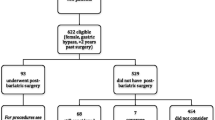Abstract
Background
Bariatric surgery has substantial health benefits; however, some patients desire body contouring (BC) procedures following rapid weight loss. There is a paucity of data regarding the true rate of BC following bariatric procedures. The purpose of our study is to examine the utilization of two common procedures, abdominoplasty, and panniculectomy, following bariatric surgery in New York State.
Methods
The SPARCS longitudinal administrative database was used to identify bariatric procedures by using ICD-9 and CPT codes between 2004 and 2010. Procedures included sleeve gastrectomy, Roux-en-Y gastric bypass, and laparoscopic adjustable gastric banding. Using a unique patient identifier, we tracked those patients who subsequently underwent either abdominoplasty or panniculectomy with at least a 4-year follow-up (until 2014). Multivariable Cox proportional hazard model was used to evaluate predictors of follow-up BC surgery.
Results
37,806 patients underwent bariatric surgery between 2004 and 2010. Only 5.58% (n = 2112) of these patients subsequently had a BC procedure, with 143 of them (6.8%) having ≥1 plastic surgery. The average time to plastic surgery after band, bypass, or sleeve was 1134.83 ± 671.09, 984.70 ± 570.53, and 903.02 ± 497.31 days, respectively (P < 0.0001). Following the multivariable Cox proportional hazard model, a female, SG patients, patients with Medicare or Medicaid, and patients in either <20 or >80%ile in yearly income were more likely to have plastic surgery after adjusting for age, race/ethnicity, comorbidities and complications (P values < 0.0001).
Conclusions
This study shows that plastic surgery is completed by only 6% of patients following bariatric procedures. As insurance and income are associated with pursuing surgery, improved access may increase the number of patients who are able to undergo these reconstructive procedures.
Similar content being viewed by others
References
Ogden CL, Carroll MD, Fryar CD, Flegal KM. Prevalence of Obesity Among Adults and Youth: United States, 2011–2014. NCHS Data Brief, 2015. 219.
Pories WJ. Bariatric surgery: risks and rewards. J Clin Endocrinol Metab. 2008;93(11 Suppl 1):S89–96.
Kitzinger HB, Abayev S, Pittermann A, et al. The prevalence of body contouring surgery after gastric bypass surgery. Obes Surg. 2012;22(1):8–12.
Staalesen T, Olbers T, Dahlgren J, et al. Development of excess skin and request for body-contouring surgery in postbariatric adolescents. Plast Reconstr Surg. 2014;134(4):627–36.
Song AY, Rubin JP, Thomas V, et al. Body image and quality of life in post massive weight loss body contouring patients. Obesity (Silver Spring). 2006;14(9):1626–36.
Azin A, Zhou C, Jackson T, et al. Body contouring surgery after bariatric surgery: a study of cost as a barrier and impact on psychological well-being. Plast Reconstr Surg. 2014;133(6):776e–82e.
Steffen KJ, Sarwer DB, Thompson JK, et al. Predictors of satisfaction with excess skin and desire for body contouring after bariatric surgery. Surg Obes Relat Dis. 2012;8(1):92–7.
Mitchell JE, Crosby RD, Ertelt TW, et al. The desire for body contouring surgery after bariatric surgery. Obes Surg. 2008;18(10):1308–12.
The American Society of Plastic Surgeons. New Statistics Reflect the Changing Face of Pastic Surgery. 2015. Accessed at https://www.plasticsurgery.org/news/press-releases/new-statistics-reflect-the-changing-face-of-plastic-surgery on 4/15/2017.
Gurunluoglu R. Insurance coverage criteria for panniculectomy and redundant skin surgery after bariatric surgery: why and when to discuss. Obes Surg. 2009;19(4):517–20.
Vilà J, Balibreat JM, Oller B, et al. Post-bariatric surgery body contouring treatment in the public health system: cost study and perception by patients. Plast Reconstr Surg. 2014;134(3):448–54.
Charlson ME, Pompei P, Ales KL, et al. A new method of classifying prognostic comorbidity in longitudinal studies: development and validation. J Chronic Dis. 1987;40(5):373–83.
Sarwer DB. The psychological aspects of cosmetic breast augmentation. Plast Reconstr Surg. 2007;120:110S–7S.
Sioka E, Tzovaras G, Katsogridaki G, et al. Desire for body contouring surgery after laparoscopic sleeve gastrectomy. Aesthet Plast Surg. 2015;39(6):978–84.
Mitchell R, Rubin JP. Discussion: post-bariatric surgery body contouring treatment in the public health system: cost study and perception by patients. Plast Reconstr Surg. 2014;134(3):455–6.
Felberbauer FX, Shakeri-Leidenmuhler S, Langer FB, et al. Post-bariatric body-contouring surgery: fewer procedures, less demand, and lower costs. Obes Surg. 2015;25(7):1198–202.
Acknowledgements
We would like to thank the statistical support from the Biostatistical Consulting Core, School of Medicine, Stony Brook University.
Author information
Authors and Affiliations
Corresponding author
Ethics declarations
Conflict of Interest
Author 1, Author 2, Author 3, Author 4, Author 5, Author 6, Author 7, and Author 8 have nothing to disclose. Author 9 reports honoraria for speaking for Ethicon, Medtronic, Stryker, and Gore; and is a consultant for Medicines Company and Merck.
Ethical Approval
All procedures performed in studies involving human participants were in accordance with the ethical standards of the institutional and/or national research committee and with the 1964 Helsinki declaration and its later amendments or comparable ethical standards.
Informed Consent
Does not apply to this study.
Funding
No industry or other external funding was used for this research. Dr. Pryor receives honoraria for speaking for Ethicon, Medtronic, and Gore; is a consultant for Freehold Medical and Intuitive, and has ownership interest in Transenterix.
Additional information
This work was presented at the Scientific Forum at the American College of Surgeons, Washington DC 2016.
Rights and permissions
About this article
Cite this article
Altieri, M.S., Yang, J., Park, J. et al. Utilization of Body Contouring Procedures Following Weight Loss Surgery: A Study of 37,806 Patients. OBES SURG 27, 2981–2987 (2017). https://doi.org/10.1007/s11695-017-2732-4
Published:
Issue Date:
DOI: https://doi.org/10.1007/s11695-017-2732-4




